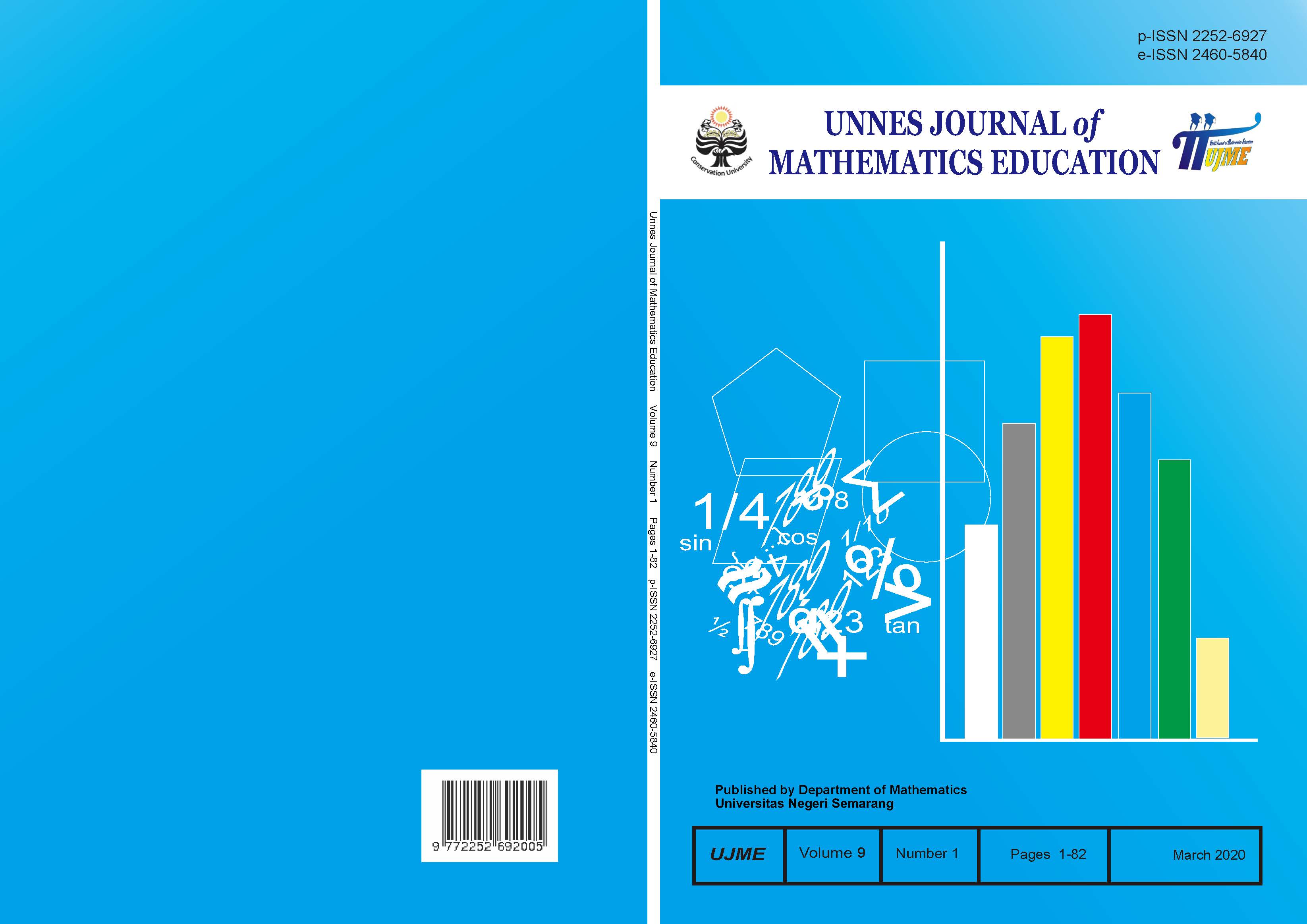Mathematical creative thinking ability observed from student learning motivation in Jigsaw Cooperative Learning assisted by problem cards
##plugins.themes.academic_pro.article.main##
Abstract
The study aims to test the completeness Jigsaw cooperative learning assisted by problem cards for student’s mathematical creative thinking ability, to test the mathematical creative thinking abilities of students in Jigsaw cooperative learning assisted by problem cards compared with conventional learning, and analyze mathematical creative thinking abilities of students in Jigsaw cooperative learning assisted by problem cards observed from student’s learning motivation. The study uses mixed methods sequential explanatory design. Subjects in this study are six students of Junior High School in Semarang of class VIII B represent each group of learning motivation. Data collection methods used as follows: questionnaire, test, and interview. The result shows that: (1) student’s mathematical creative thinking ability in Jigsaw cooperative learning assisted by problem cards reaches learning completeness, (2) student’s mathematical creative thinking ability in Jigsaw cooperative learning assisted by problem cards higher than mathematical creative thinking ability in conventional learning, (3) student’s mathematical creative thinking ability observed from learning motivation are: (a) student with high learning motivation able to achieve all mathematical creative thinking ability indicators; (b) student with average learning motivation able to achieve fluency and elaboration indicators, but not achieve the flexibility and originality indicators; (c) student with low learning motivation less able to achieve fluency, flexibility, originality, and elaboration indicators.
##plugins.themes.academic_pro.article.details##
References
Akhsani, L. & Puji R. 2017. Deskripsi Kemampuan Berpikir Kreatif Matematis Dan Motivasi
Belajar Siswa Smp Negeri 1 Sumbang. Journal of Mathematics Education 3(2):75-81.
Anwar, K. 2014. Peningkatan Aktivitas dan Hasil Belajar Siswa dalam Turunan Fungsi melalui Model Pembelajaran Jigsaw Berbantuan Studet Activities Handout. Jurnal Kreano. 5(2):133- 142.
Dat, T.V. 2016. The Effect of Jigsaw Learning on Student’s Knowledge Retention Vietnamese Higher Education. International Journal of Higher Education. 5(2):236-253.
Depdiknas, (2016). Permendikbud RI No 21 Tahun 2016 Tentang Standar Isi Pendidikan Dasar dan Menengah. Jakarta: Deparetemen Pendidikan Nasional.
Ermistri, A.I. 2017. Hubungan antara Motivasi Belajar dengan Berpikir Kreatif Matematis pada Siswa di Kelas VII. Jurnal Pendidikan dan Pembelajaran. 6(6):1-9.
Florentina, N & Leonard.2017. Pengaruh Model Pembelajaran Kooperatif Terhadap Kemampuan Berpikir Kreatif Matematis Siswa. Jurnal Formatif 7(2): 96-106.
Heruman. 2009. Model Pembelajaran Matematika di Sekolah Dasar. Bandung: PT Remaja Rosdakarya.
Kadir, Lucyana, & Satriawati.G. 2017. The Implementation of Open-Inquiry Approach to Improve Students’ Learning Activities, Responses, and Mathematical Creative Thinking Skills. Journal on Mathematics Education. 8(1):103-114.
Lestari, K. E & M. R. Yudhanegara. 2015. Penelitian Pendidikan Matematika. Bandung: PT Refika Aditama.
Munandar, U. 2012. Kreativitas&Keberbakatan: Strategi Mewujudkan Potensi Kreatif & Bakat. Jakarta: PT Gramedia Pustaka Utama.
Nur I.M. & In Hi Abdullah. 2014. Penggunaan Model Pembelajaran Kooperatif Tipe Jigsaw Untuk Meningkatkan Kemampuan Berpikir Kreatif Dan Soft Skill Matematis Siswa Sma. Delta-Pi: Jurnal Matematika dan Pendidikan Matematika. 3(2): 39-53.
OECD. 2016. PISA 2015: Results in Focus. Tersedia di https://www.oecd.org/pisa/pisa- 2015-results-in-focus.pdf [28-12-2016].
Pratiwi, L.A., Dwijanto & K. Wijayanti. 2019. Analisis Kemampuan Berpikir Kreatif Matematis pada Pembelajaran Read, Think,
Talk, Write Ditinjau dari Kecemasan Matematika. Prisma. (2):576-582.
Provasnik, S., D. Kastberg, D. Ferraro, N. Lemanski, S. Roey, & F. Jenkins. 2016. Highlights From TIMSS and TIMSS Advanced 2015: Mathematics and Science Achievement of U.S. Students in Grades 4 and 8 and in Advanced Courses at the End of High School in an International Context.Washington, DC: National Center for Education Statistics, Institute of Education Sciences, U.S. Department of Education.
Sardiman, A.M. 2014. Interaksi dan Motivasi Belajar Mengajar. Jakarta: Rajawali Pers.
Siswono, T.Y.E. (2010). Leveling Students’ Creative Thinking in Solving and Possing Mathematical Problem IndoMS. J.ME. 1(1).17- 40.
Suherman, E., et al. 2003. Strategi Pembelajaran Matematika Kontenporer.Bandung: JICA.
Tampubolon, S.M.2014.Penelitian Tindakan Kelas Sebagai Pengembangan Profesi Pendidik dan Keilmuan.Jakarta:Erlangga.
Turgut, S. & G. Turgut. 2018. The Effects of Cooperative Learning on Mathematics Achievement in Turkey: A Meta-Analysis Study. International Journal of Instruction. 11(3):663.
Uno, H. 2008. Teori Motivasi dan Pengukurannya.
Jakarta: Bumi Aksara.
Yoselin, K., Kartono dan Soedjoko, E. 2016. Komparasi Pembelajaran Matematika dengan Model Jigsaw dan GI pada Pencapaian Kemampuan Pemecahan Masalah. Unnes Journal of Mathematics Education. 5(1):33-39.
